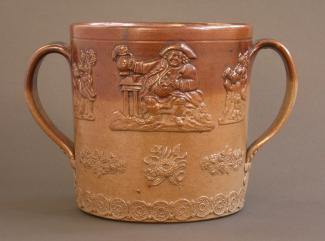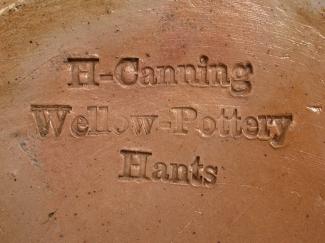Despite February bringing St Valentine’s Day, the kind of love referred to in the term ‘loving cup’ was really the kind belonging to friendship rather than romance - picture a communal feast, not too gentrified, the brimming cup of ale passing hand-to-hand and swig-by-swig along the benches.
The loving cup shown here was made in the 1850s. The brown stoneware is enlivened by ‘sprigs’ (3-dimensional applied ornament), including one of Toby Fillpot, an amiable drunkard of fiction who is supposed to have inspired the first Toby Jugs. So far nothing unusual; in appearance it’s like many other loving cups made in the mid-19th century. However, turn it up and you see it didn’t come from one of the main stoneware manufacturing areas - London, Nottingham or Derbyshire - but ostensibly from Wellow in Hampshire. For many years this has been a mystery because no other pot exists with the “H Canning / Wellow Pottery / Hants” mark and there is no documentary evidence of such a pottery having been in the village.
On the other hand, there is evidence that for a short time in the mid 1850s a Henry Canning of Greenwich together with one Cornelius Beavis of Southampton ran a brickworks in Wellow where the current A36 meets the Wiltshire border. Still, stoneware manufacture calls for more advanced technology. Though the local clay might have been suitable there would have been no local know-how. Even the look of the cup suggests a London maker, adding weight to the theory that the mark is a ploy - that the item was made elsewhere in order to drum up money for a projected transformation of the brickworks into a stoneware pottery that didn’t quite come off.
Maybe after that Canning went back to Greenwich. There is no other trace of him in Hampshire. Coincidentally, loving cups start to disappear at about this same time. Though they continued to be made they were more often novelty items or commemoratives rather than normal accompaniments to merry-making. And now too the living tradition surrounding that use is lost, just as in the case of an earlier class of loving cup from Dorset which featured an integral moulded whistle - now what, as the younger generation are inclined to say, was that all about?




